TOYOTA BZ4X 2022 Owners Manual (in English)
Manufacturer: TOYOTA, Model Year: 2022, Model line: BZ4X, Model: TOYOTA BZ4X 2022Pages: 674, PDF Size: 120.02 MB
Page 241 of 674
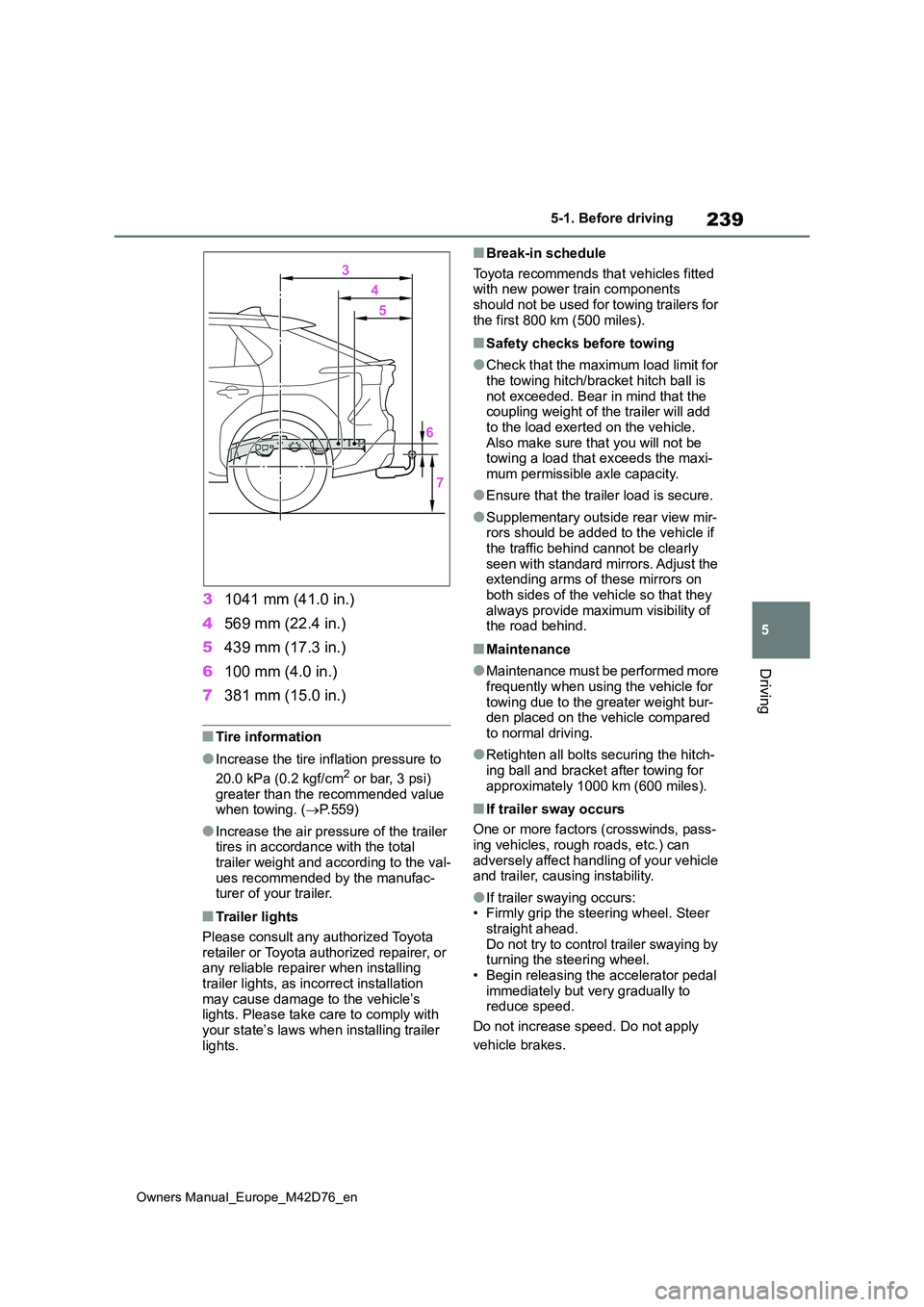
239
5
Owners Manual_Europe_M42D76_en
5-1. Before driving
Driving
31041 mm (41.0 in.)
4 569 mm (22.4 in.)
5 439 mm (17.3 in.)
6 100 mm (4.0 in.)
7 381 mm (15.0 in.)
■Tire information
●Increase the tire inflation pressure to
20.0 kPa (0.2 kgf/cm2 or bar, 3 psi) greater than the recommended value when towing. ( P.559)
●Increase the air pressure of the trailer tires in accordance with the total
trailer weight and according to the val- ues recommended by the manufac-turer of your trailer.
■Trailer lights
Please consult any authorized Toyota retailer or Toyota authorized repairer, or any reliable repairer when installing
trailer lights, as incorrect installation may cause damage to the vehicle’s lights. Please take care to comply with
your state’s laws when installing trailer lights.
■Break-in schedule
Toyota recommends that vehicles fitted with new power train components should not be used for towing trailers for
the first 800 km (500 miles).
■Safety checks before towing
●Check that the maximum load limit for
the towing hitch/bracket hitch ball is not exceeded. Bear in mind that the coupling weight of the trailer will add
to the load exerted on the vehicle. Also make sure that you will not be towing a load that exceeds the maxi-
mum permissible axle capacity.
●Ensure that the trailer load is secure.
●Supplementary outside rear view mir- rors should be added to the vehicle if
the traffic behind cannot be clearly seen with standard mirrors. Adjust the extending arms of these mirrors on
both sides of the vehicle so that they always provide maximum visibility of the road behind.
■Maintenance
●Maintenance must be performed more frequently when using the vehicle for
towing due to the greater weight bur- den placed on the vehicle compared to normal driving.
●Retighten all bolts securing the hitch-ing ball and bracket after towing for
approximately 1000 km (600 miles).
■If trailer sway occurs
One or more factors (crosswinds, pass- ing vehicles, rough roads, etc.) can
adversely affect handling of your vehicle and trailer, causing instability.
●If trailer swaying occurs:• Firmly grip the steering wheel. Steer straight ahead.
Do not try to control trailer swaying by turning the steering wheel.• Begin releasing the accelerator pedal
immediately but very gradually to reduce speed.
Do not increase speed. Do not apply
vehicle brakes.
Page 242 of 674
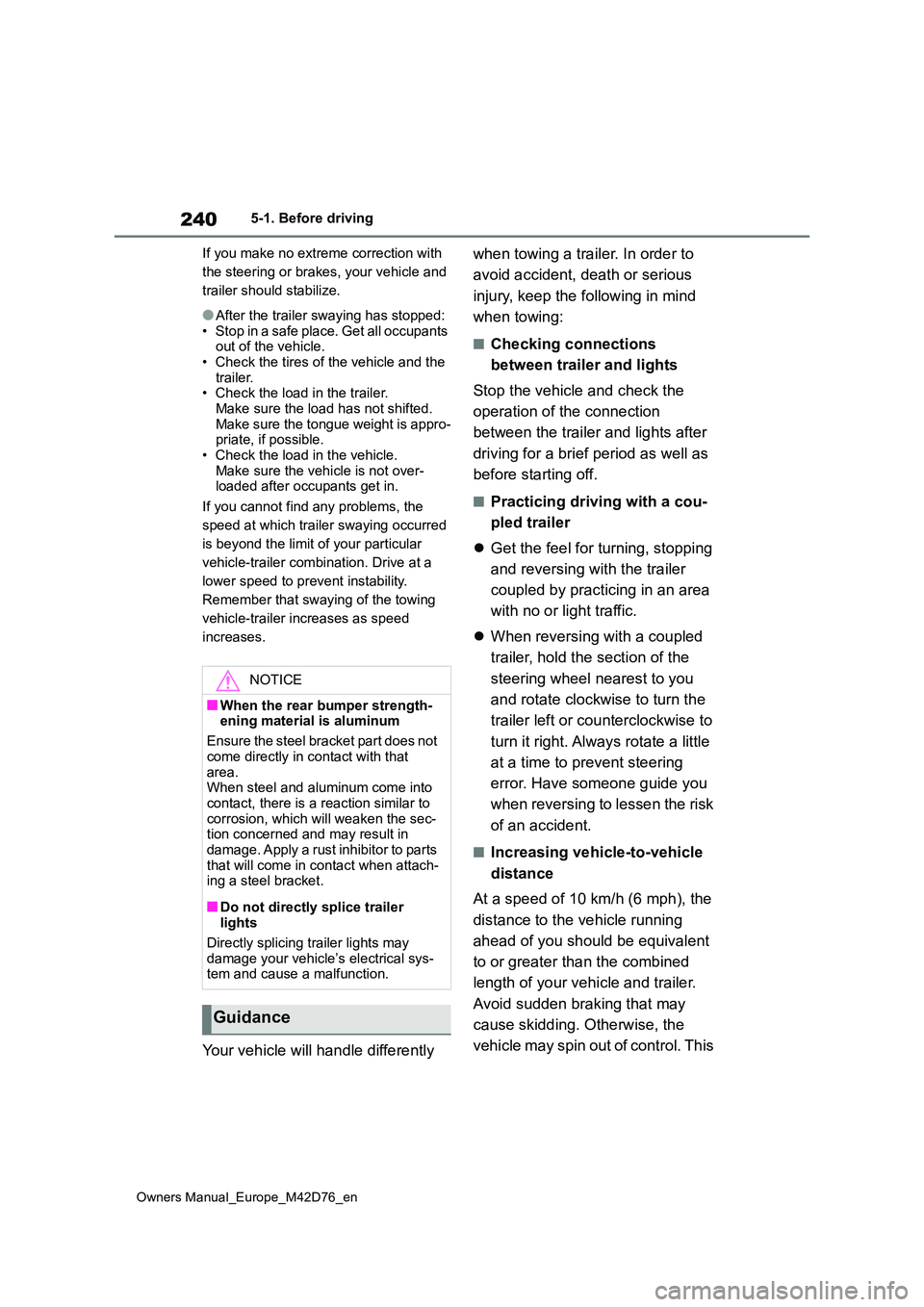
240
Owners Manual_Europe_M42D76_en
5-1. Before driving
If you make no extreme correction with
the steering or brakes, your vehicle and
trailer should stabilize.
●After the trailer swaying has stopped: • Stop in a safe place. Get all occupants out of the vehicle.
• Check the tires of the vehicle and the trailer.• Check the load in the trailer.
Make sure the load has not shifted. Make sure the tongue weight is appro-priate, if possible.
• Check the load in the vehicle. Make sure the vehicle is not over-loaded after occupants get in.
If you cannot find any problems, the
speed at which trailer swaying occurred
is beyond the limit of your particular
vehicle-trailer combination. Drive at a
lower speed to prevent instability.
Remember that swaying of the towing
vehicle-trailer increases as speed
increases.
Your vehicle will handle differently
when towing a trailer. In order to
avoid accident, death or serious
injury, keep the following in mind
when towing:
■Checking connections
between trailer and lights
Stop the vehicle and check the
operation of the connection
between the trailer and lights after
driving for a brief period as well as
before starting off.
■Practicing driving with a cou-
pled trailer
Get the feel for turning, stopping
and reversing with the trailer
coupled by practicing in an area
with no or light traffic.
When reversing with a coupled
trailer, hold the section of the
steering wheel nearest to you
and rotate clockwise to turn the
trailer left or counterclockwise to
turn it right. Always rotate a little
at a time to prevent steering
error. Have someone guide you
when reversing to lessen the risk
of an accident.
■Increasing vehicle-to-vehicle
distance
At a speed of 10 km/h (6 mph), the
distance to the vehicle running
ahead of you should be equivalent
to or greater than the combined
length of your vehicle and trailer.
Avoid sudden braking that may
cause skidding. Otherwise, the
vehicle may spin out of control. This
NOTICE
■When the rear bumper strength- ening material is aluminum
Ensure the steel bracket part does not
come directly in contact with that area.When steel and aluminum come into
contact, there is a reaction similar to corrosion, which will weaken the sec-tion concerned and may result in
damage. Apply a rust inhibitor to parts that will come in contact when attach-ing a steel bracket.
■Do not directly splice trailer lights
Directly splicing trailer lights may damage your vehicle’s electrical sys-tem and cause a malfunction.
Guidance
Page 243 of 674
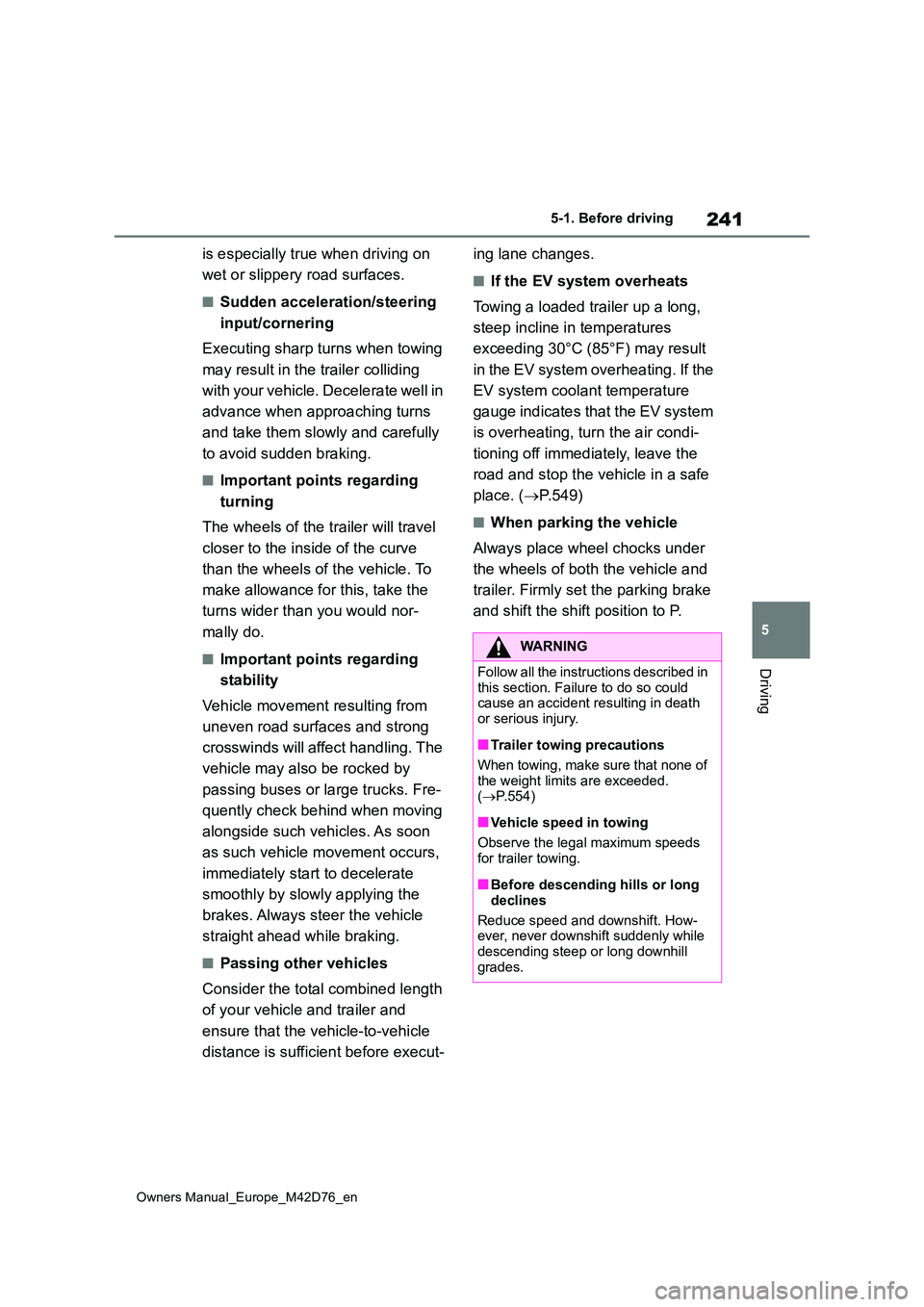
241
5
Owners Manual_Europe_M42D76_en
5-1. Before driving
Driving
is especially true when driving on
wet or slippery road surfaces.
■Sudden acceleration/steering
input/cornering
Executing sharp turns when towing
may result in the trailer colliding
with your vehicle. Decelerate well in
advance when approaching turns
and take them slowly and carefully
to avoid sudden braking.
■Important points regarding
turning
The wheels of the trailer will travel
closer to the inside of the curve
than the wheels of the vehicle. To
make allowance for this, take the
turns wider than you would nor-
mally do.
■Important points regarding
stability
Vehicle movement resulting from
uneven road surfaces and strong
crosswinds will affect handling. The
vehicle may also be rocked by
passing buses or large trucks. Fre-
quently check behind when moving
alongside such vehicles. As soon
as such vehicle movement occurs,
immediately start to decelerate
smoothly by slowly applying the
brakes. Always steer the vehicle
straight ahead while braking.
■Passing other vehicles
Consider the total combined length
of your vehicle and trailer and
ensure that the vehicle-to-vehicle
distance is sufficient before execut-
ing lane changes.
■If the EV system overheats
Towing a loaded trailer up a long,
steep incline in temperatures
exceeding 30°C (85°F) may result
in the EV system overheating. If the
EV system coolant temperature
gauge indicates that the EV system
is overheating, turn the air condi-
tioning off immediately, leave the
road and stop the vehicle in a safe
place. ( P.549)
■When parking the vehicle
Always place wheel chocks under
the wheels of both the vehicle and
trailer. Firmly set the parking brake
and shift the shift position to P.
WARNING
F o l l o w a l l t h e i n s t r u c t i o n s d e s c r i b e d i n this section. Failure to do so could cause an accident resulting in death
or serious injury.
■Trailer towing precautions
When towing, make sure that none of the weight limits are exceeded. ( P.554)
■Vehicle speed in towing
Observe the legal maximum speeds
for trailer towing.
■Before descending hills or long
declines
Reduce speed and downshift. How- ever, never downshift suddenly while
descending steep or long downhill grades.
Page 244 of 674
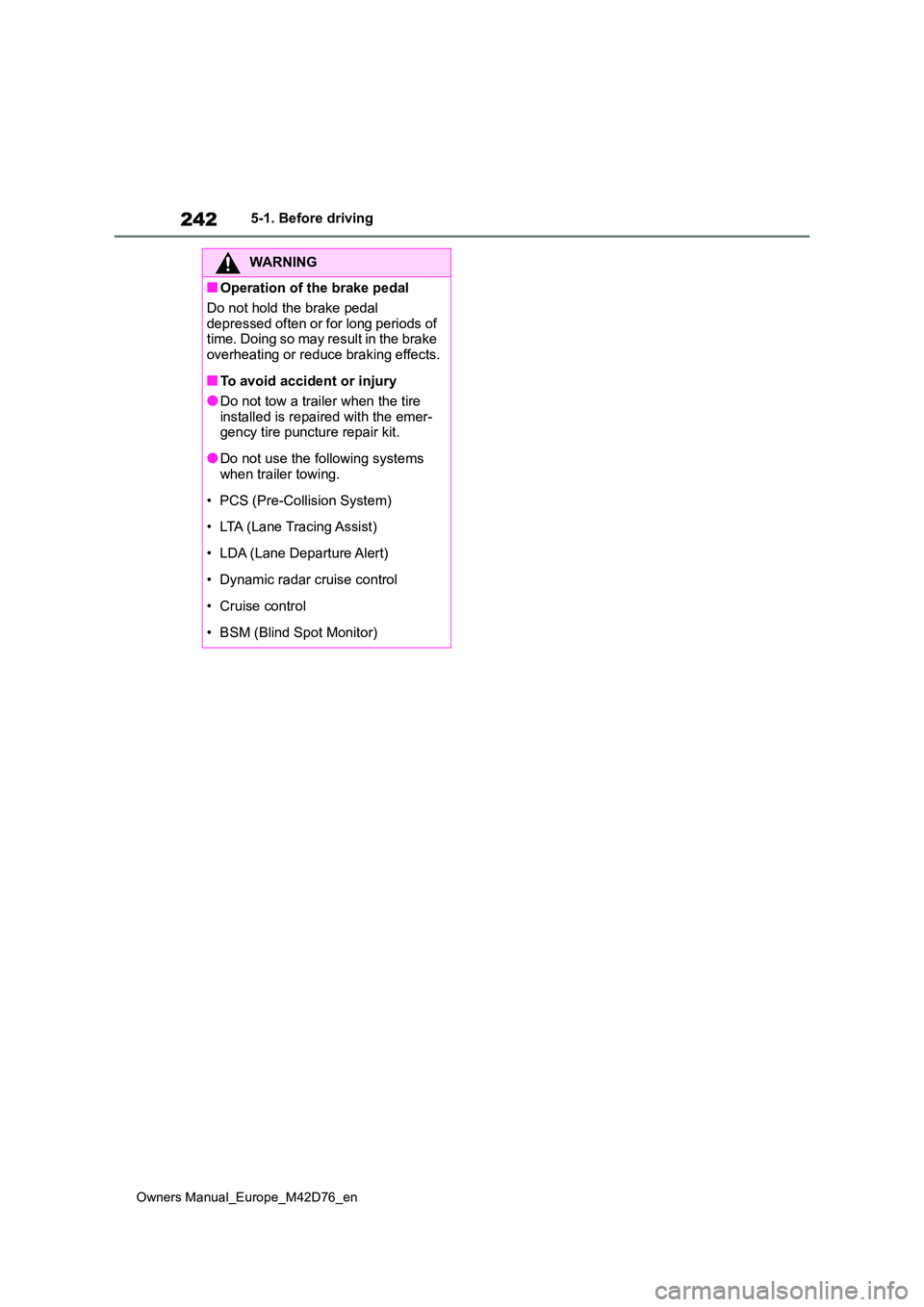
242
Owners Manual_Europe_M42D76_en
5-1. Before driving
WARNING
■Operation of the brake pedal
Do not hold the brake pedal
depressed often or for long periods of time. Doing so may result in the brake overheating or reduce braking effects.
■To avoid accident or injury
●Do not tow a trailer when the tire
installed is repaired with the emer- gency tire puncture repair kit.
●Do not use the following systems when trailer towing.
• PCS (Pre-Collision System)
• LTA (Lane Tracing Assist)
• LDA (Lane Departure Alert)
• Dynamic radar cruise control
• Cruise control
• BSM (Blind Spot Monitor)
Page 245 of 674
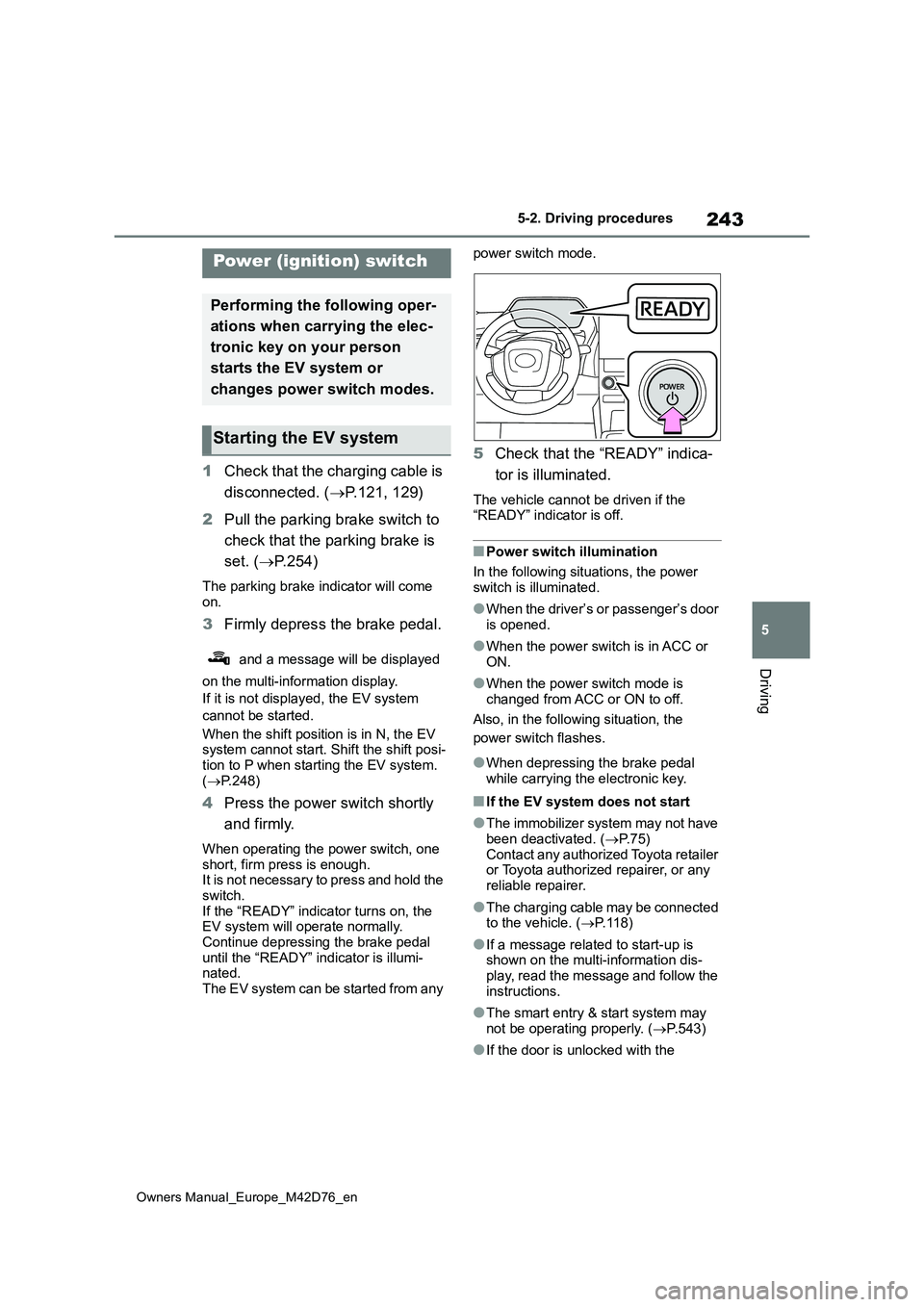
243
5
Owners Manual_Europe_M42D76_en
5-2. Driving procedures
Driving
5-2.Driving pro cedu res
1Check that the charging cable is
disconnected. ( P.121, 129)
2 Pull the parking brake switch to
check that the parking brake is
set. ( P.254)
The parking brake indicator will come on.
3 Firmly depress the brake pedal.
and a message will be displayed
on the multi-information display.
If it is not displayed, the EV system
cannot be started.
When the shift position is in N, the EV system cannot start. Shift the shift posi-
tion to P when starting the EV system. ( P.248)
4Press the power switch shortly
and firmly.
When operating the power switch, one short, firm press is enough.It is not necessary to press and hold the
switch. If the “READY” indicator turns on, the EV system will operate normally.
Continue depressing the brake pedal until the “READY” indicator is illumi-nated.
The EV system can be started from any
power switch mode.
5 Check that the “READY” indica-
tor is illuminated.
The vehicle cannot be driven if the “READY” indicator is off.
■Power switch illumination
In the following situations, the power
switch is illuminated.
●When the driver’s or passenger’s door
is opened.
●When the power switch is in ACC or
ON.
●When the power switch mode is
changed from ACC or ON to off.
Also, in the following situation, the
power switch flashes.
●When depressing the brake pedal
while carrying the electronic key.
■If the EV system does not start
●The immobilizer system may not have
been deactivated. ( P. 7 5 ) Contact any authorized Toyota retailer or Toyota authorized repairer, or any
reliable repairer.
●The charging cable may be connected to the vehicle. ( P. 1 1 8 )
●If a message related to start-up is shown on the multi-information dis-play, read the message and follow the
instructions.
●The smart entry & start system may
not be operating properly. ( P.543)
●If the door is unlocked with the
Power (ignition) switch
Performing the following oper-
ations when carrying the elec-
tronic key on your person
starts the EV system or
changes power switch modes.
Starting the EV system
Page 246 of 674
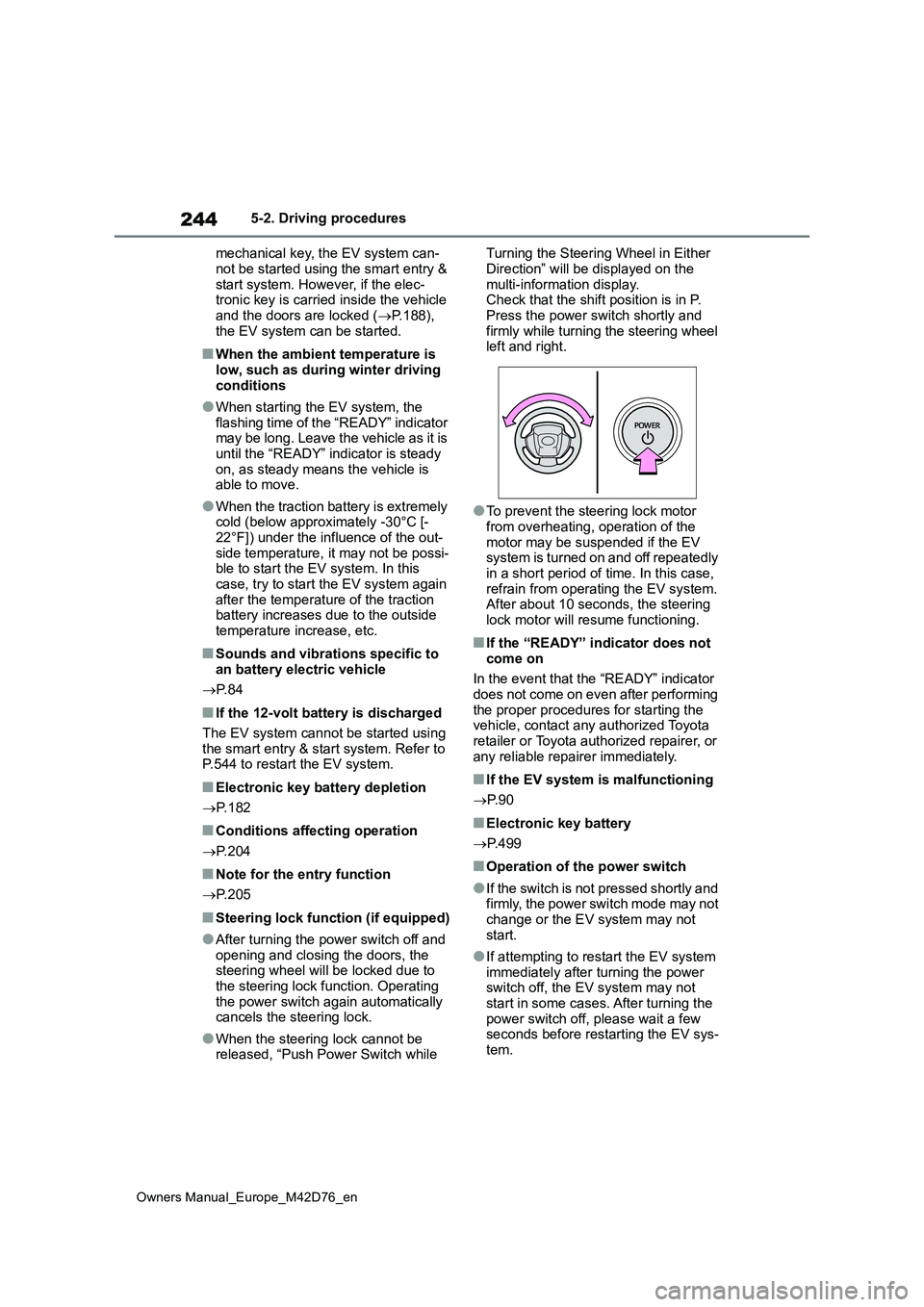
244
Owners Manual_Europe_M42D76_en
5-2. Driving procedures
mechanical key, the EV system can-
not be started using the smart entry & start system. However, if the elec-tronic key is carried inside the vehicle
and the doors are locked ( P.188), the EV system can be started.
■When the ambient temperature is low, such as during winter driving
conditions
●When starting the EV system, the
flashing time of the “READY” indicator may be long. Leave the vehicle as it is until the “READY” indicator is steady
on, as steady means the vehicle is able to move.
●When the traction battery is extremely cold (below approximately -30°C [-22°F]) under the influence of the out-
side temperature, it may not be possi- ble to start the EV system. In this case, try to start the EV system again
after the temperature of the traction battery increases due to the outside temperature increase, etc.
■Sounds and vibrations specific to
an battery electric vehicle
P. 8 4
■If the 12-volt battery is discharged
The EV system cannot be started using
the smart entry & start system. Refer to P.544 to restart the EV system.
■Electronic key battery depletion
P. 1 8 2
■Conditions affecting operation
P. 2 0 4
■Note for the entry function
P. 2 0 5
■Steering lock function (if equipped)
●After turning the power switch off and opening and closing the doors, the steering wheel will be locked due to
the steering lock function. Operating the power switch again automatically cancels the steering lock.
●When the steering lock cannot be released, “Push Power Switch while
Turning the Steering Wheel in Either
Direction” will be displayed on the multi-information display.Check that the shift position is in P.
Press the power switch shortly and firmly while turning the steering wheel left and right.
●To prevent the steering lock motor from overheating, operation of the
motor may be suspended if the EV system is turned on and off repeatedly in a short period of time. In this case,
refrain from operating the EV system. After about 10 seconds, the steering lock motor will resume functioning.
■If the “READY” indicator does not
come on
In the event that the “READY” indicator does not come on even after performing
the proper procedures for starting the vehicle, contact any authorized Toyota retailer or Toyota authorized repairer, or
any reliable repairer immediately.
■If the EV system is malfunctioning
P. 9 0
■Electronic key battery
P. 4 9 9
■Operation of the power switch
●If the switch is not pressed shortly and firmly, the power switch mode may not
change or the EV system may not start.
●If attempting to restart the EV system immediately after turning the power switch off, the EV system may not
start in some cases. After turning the power switch off, please wait a few seconds before restarting the EV sys-
tem.
Page 247 of 674
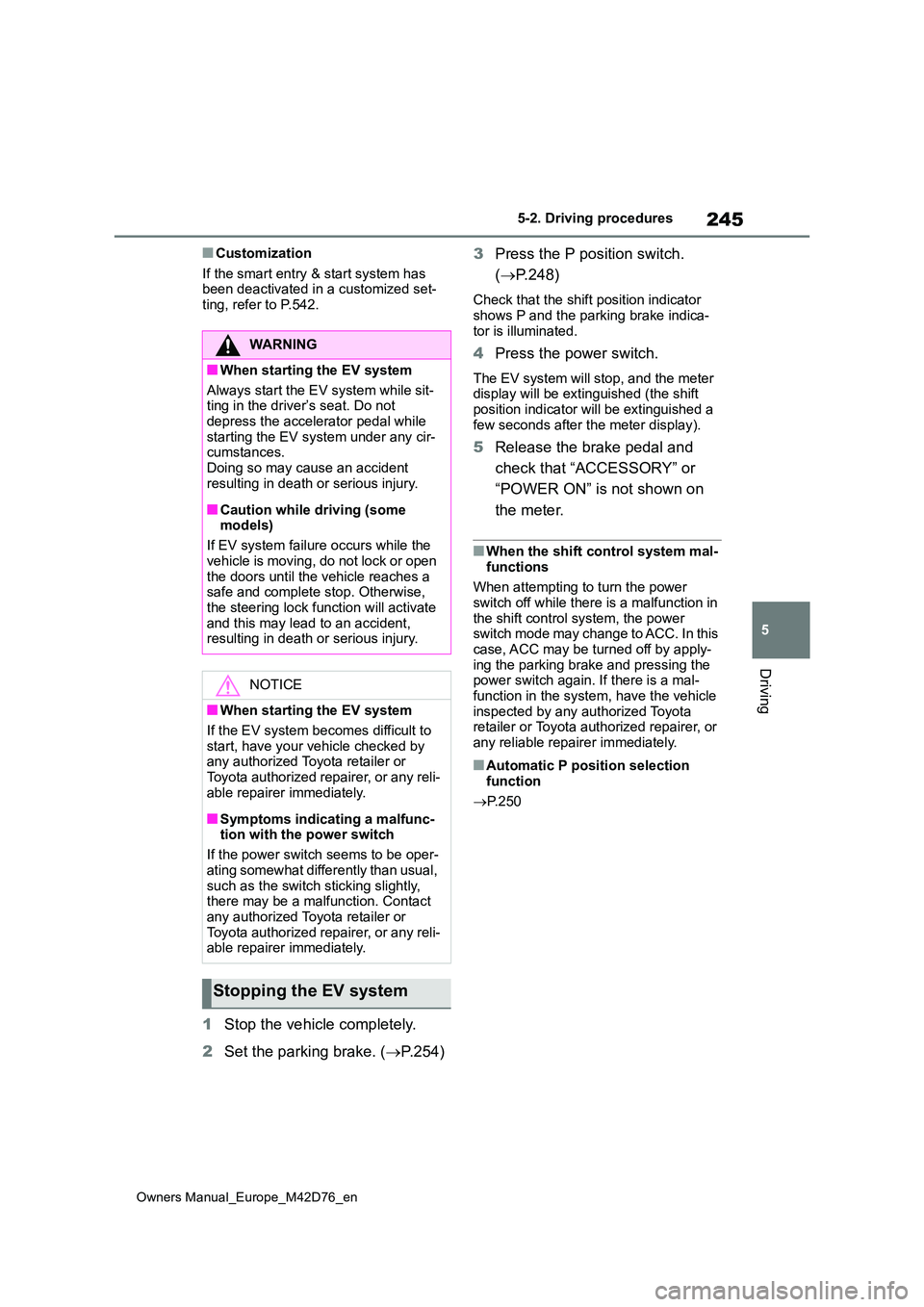
245
5
Owners Manual_Europe_M42D76_en
5-2. Driving procedures
Driving
■Customization
If the smart entry & start system has been deactivated in a customized set-ting, refer to P.542.
1 Stop the vehicle completely.
2 Set the parking brake. (P.254)
3 Press the P position switch.
( P.248)
Check that the shift position indicator
shows P and the parking brake indica- tor is illuminated.
4 Press the power switch.
The EV system will stop, and the meter display will be extinguished (the shift
position indicator will be extinguished a few seconds after the meter display).
5 Release the brake pedal and
check that “ACCESSORY” or
“POWER ON” is not shown on
the meter.
■When the shift control system mal-
functions
When attempting to turn the power switch off while there is a malfunction in
the shift control system, the power switch mode may change to ACC. In this case, ACC may be turned off by apply-
ing the parking brake and pressing the power switch again. If there is a mal-function in the system, have the vehicle
inspected by any authorized Toyota retailer or Toyota authorized repairer, or any reliable repairer immediately.
■Automatic P position selection
function
P. 2 5 0
WARNING
■When starting the EV system
Always start the EV system while sit- ting in the driver’s seat. Do not
depress the accelerator pedal while starting the EV system under any cir-cumstances.
Doing so may cause an accident resulting in death or serious injury.
■Caution while driving (some models)
If EV system failure occurs while the
vehicle is moving, do not lock or open the doors until the vehicle reaches a safe and complete stop. Otherwise,
the steering lock function will activate and this may lead to an accident, resulting in death or serious injury.
NOTICE
■When starting the EV system
If the EV system becomes difficult to start, have your vehicle checked by any authorized Toyota retailer or
Toyota authorized repairer, or any reli- able repairer immediately.
■Symptoms indicating a malfunc-tion with the power switch
If the power switch seems to be oper-
ating somewhat differently than usual, such as the switch sticking slightly, there may be a malfunction. Contact
any authorized Toyota retailer or Toyota authorized repairer, or any reli-able repairer immediately.
Stopping the EV system
Page 248 of 674
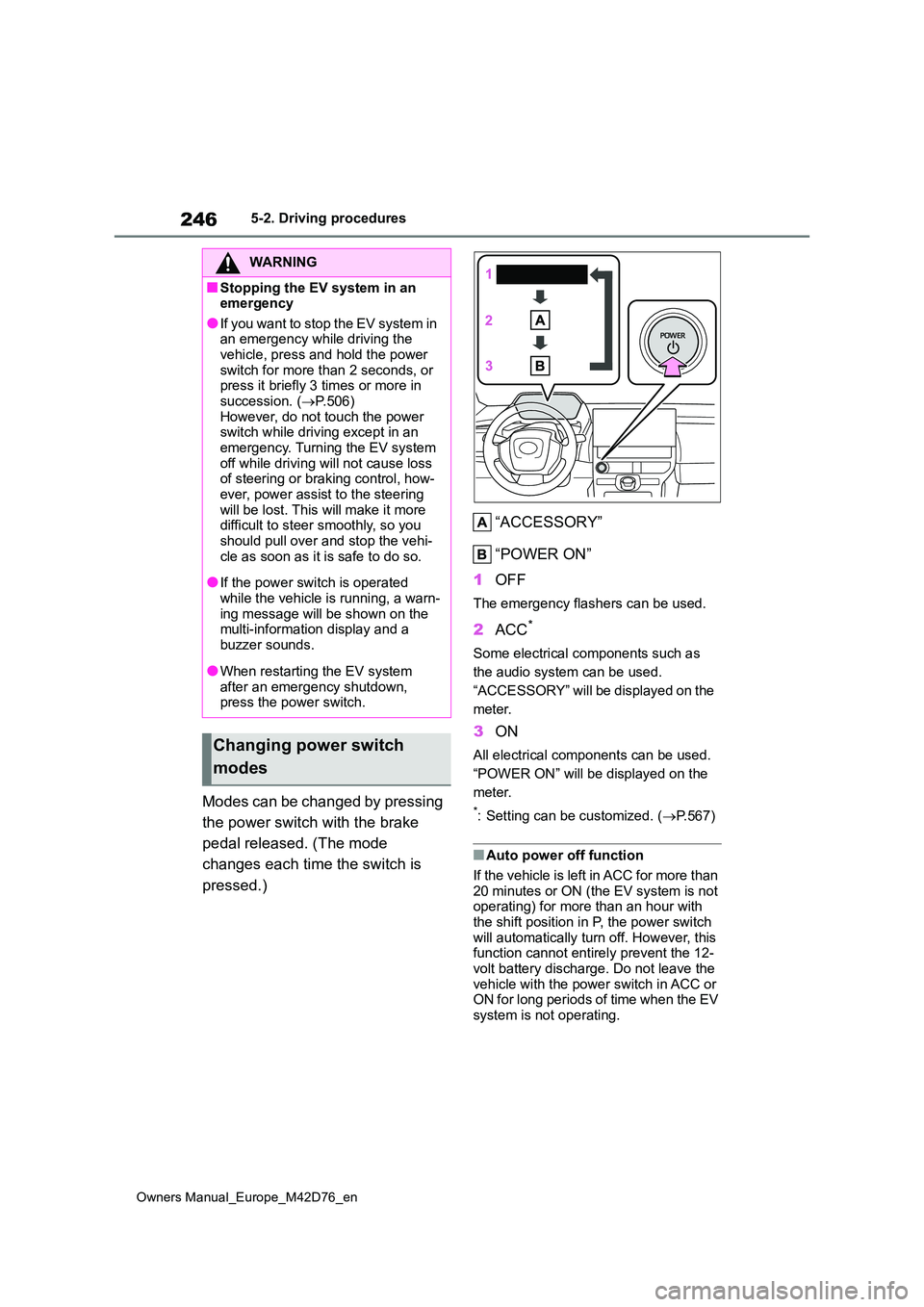
246
Owners Manual_Europe_M42D76_en
5-2. Driving procedures
Modes can be changed by pressing
the power switch with the brake
pedal released. (The mode
changes each time the switch is
pressed.)
“ACCESSORY”
“POWER ON”
1 OFF
The emergency flashers can be used.
2ACC*
Some electrical components such as
the audio system can be used.
“ACCESSORY” will be displayed on the
meter.
3 ON
All electrical components can be used.
“POWER ON” will be displayed on the
meter.
*: Setting can be customized. ( P.567)
■Auto power off function
If the vehicle is left in ACC for more than
20 minutes or ON (the EV system is not operating) for more than an hour with the shift position in P, the power switch
will automatically turn off. However, this function cannot entirely prevent the 12-volt battery discharge. Do not leave the
vehicle with the power switch in ACC or ON for long periods of time when the EV system is not operating.
WARNING
■Stopping the EV system in an emergency
●If you want to stop the EV system in an emergency while driving the vehicle, press and hold the power
switch for more than 2 seconds, or press it briefly 3 times or more in succession. ( P.506)
However, do not touch the power switch while driving except in an emergency. Turning the EV system
off while driving will not cause loss of steering or braking control, how-ever, power assist to the steering
will be lost. This will make it more difficult to steer smoothly, so you should pull over and stop the vehi-
cle as soon as it is safe to do so.
●If the power switch is operated
while the vehicle is running, a warn- ing message will be shown on the multi-information display and a
buzzer sounds.
●When restarting the EV system
after an emergency shutdown, press the power switch.
Changing power switch
modes
Page 249 of 674

247
5
Owners Manual_Europe_M42D76_en
5-2. Driving procedures
Driving
■Restraining sudden start (Drive-
Start Control)
P. 2 3 4
■If a message about a shift operation is shown
To prevent the shift position from being selected incorrectly or the vehicle from moving unexpectedly, the shift position
may be changed automatically or oper- ating the rotary shifter may be required. In this case, change the shift position
following the messages on the multi- information display.
■After recharging/reconnecting the 12-volt battery
P. 4 7 4
NOTICE
■To prevent 12-volt battery dis- charge
●Do not leave the power switch in ACC or ON for long periods of time without the EV system on.
●If “ACCESSORY” or “POWER ON” is displayed on the multi-informa-
tion display while the EV system is not operating, the power switch is not OFF. Exit the vehicle after turn-
ing the power switch off.
Transmission
Select the shift position
depending on your purpose
and situation.
Shift position purpose and
functions
Shift positionObjective or function
P
Parking the vehi-
cle/starting the EV sys-
tem
RReversing
N
Neutral
(Condition in which the
power is not transmit-
ted)
DNormal driving
Page 250 of 674
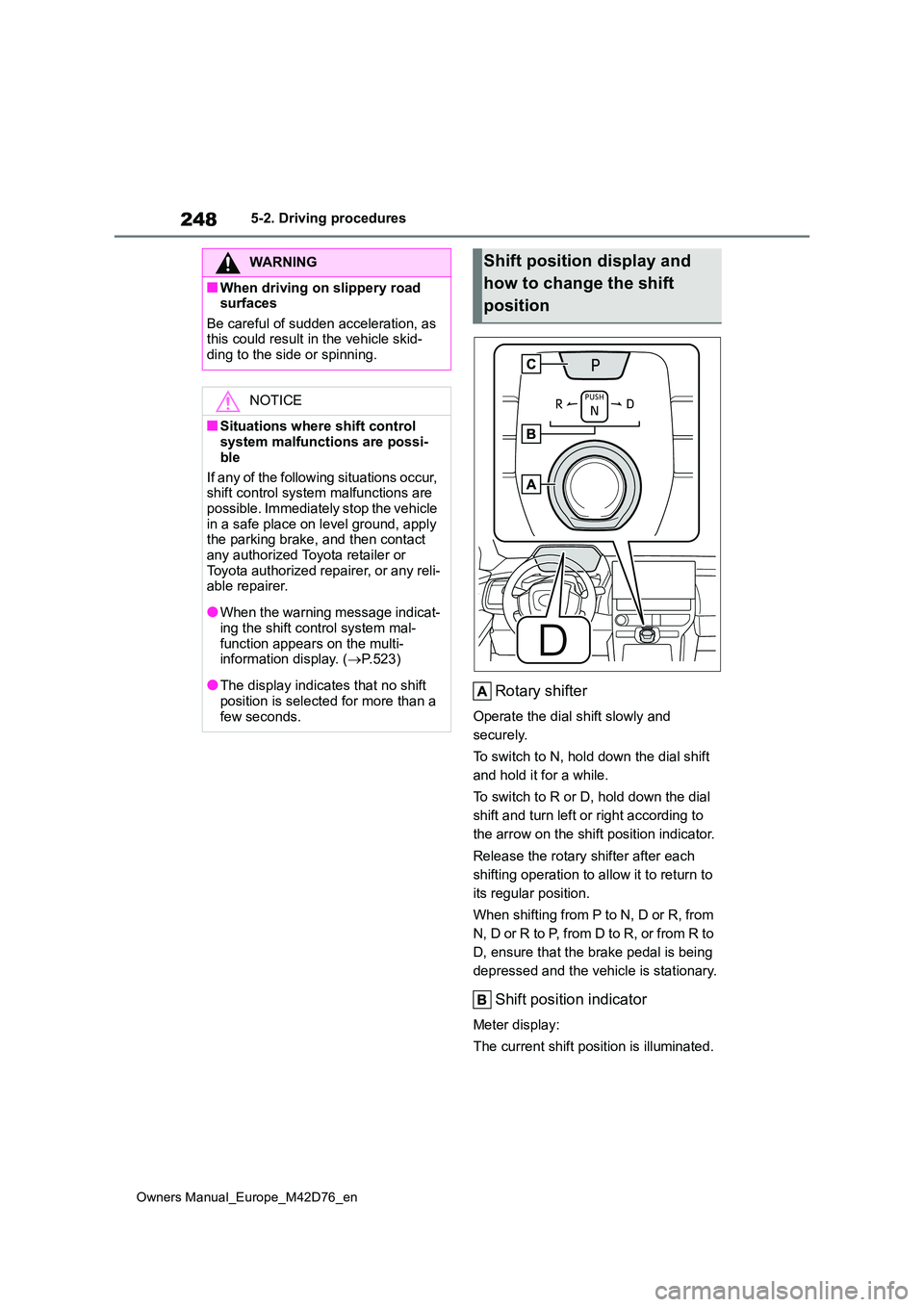
248
Owners Manual_Europe_M42D76_en
5-2. Driving procedures
Rotary shifter
Operate the dial shift slowly and
securely.
To switch to N, hold down the dial shift
and hold it for a while.
To switch to R or D, hold down the dial
shift and turn left or right according to
the arrow on the shift position indicator.
Release the rotary shifter after each
shifting operation to allow it to return to
its regular position.
When shifting from P to N, D or R, from
N, D or R to P, from D to R, or from R to
D, ensure that the brake pedal is being
depressed and the vehicle is stationary.
Shift position indicator
Meter display:
The current shift position is illuminated.
WARNING
■When driving on slippery road surfaces
Be careful of sudden acceleration, as this could result in the vehicle skid-ding to the side or spinning.
NOTICE
■Situations where shift control system malfunctions are possi-
ble
If any of the following situations occur, shift control system malfunctions are
possible. Immediately stop the vehicle in a safe place on level ground, apply the parking brake, and then contact
any authorized Toyota retailer or Toyota authorized repairer, or any reli-able repairer.
●When the warning message indicat-ing the shift control system mal-
function appears on the multi- information display. ( P.523)
●The display indicates that no shift position is selected for more than a
few seconds.
Shift position display and
how to change the shift
position